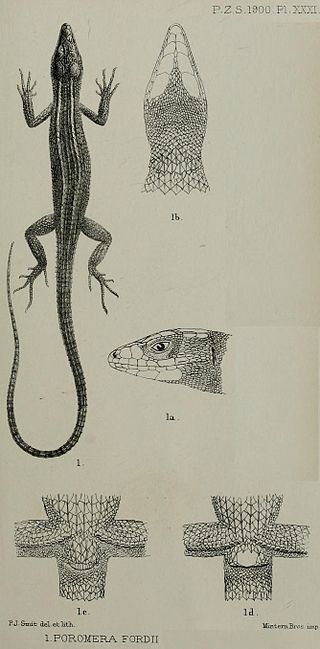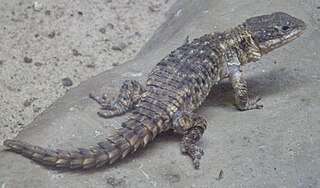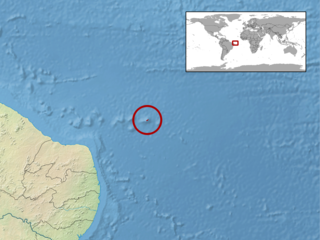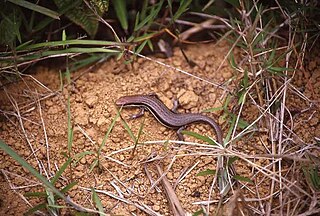
Poromera is a genus of lizard in the family Lacertidae. The genus Poromera is monotypic, containing the single species, Poromera fordii, commonly known as the West African striped lizard. The species is endemic to western Central Africa.
Ecpleopus is a genus of lizard in the family Gymnophthalmidae. The genus contains only one species, Ecpleopus gaudichaudii, which is endemic to Brazil.

George Albert Boulenger was a Belgian-British zoologist who described and gave scientific names to over 2,000 new animal species, chiefly fish, reptiles, and amphibians. Boulenger was also an active botanist during the last 30 years of his life, especially in the study of roses.

Riopa guentheri, commonly known as Günther's supple skink and Günther's writhing skink, is a species of lizard in the family Scincidae. The species is endemic to India.
Eutropis beddomei, commonly known as Beddome's mabuya or Beddome's skink, is a species of lizard in the family Scincidae. The species is native to India and Sri Lanka.
Ristella guentheri, commonly known as Günther's ristella and Gunther's cat skink, is a species of lizard in the family Scincidae. The species is endemic to India.

Sphenomorphus dussumieri, commonly known as Dussumier's forest skink and Dussumier's litter skink, is a species of skink, a lizard in the family Scincidae. The species is endemic to southern India.

Wright's skink, also known commonly as Wright's mabuya, is a species of lizard in the family Scincidae. The species is endemic to Seychelles. There are two recognized subspecies.
Wiegmann's tree lizard is a species of lizard in the family Leiosauridae. The species is endemic to South America.

The Limpopo girdled lizard, also known commonly as Jones's armadillo lizard and Jones's girdled lizard, is a species of lizard in the family Cordylidae. The species is endemic to Southern Africa.

The Noronha skink is a species of skink from the island of Fernando de Noronha off northeastern Brazil. It is covered with dark and light spots on the upperparts and is usually about 7 to 10 cm in length. The tail is long and muscular, but breaks off easily. Very common throughout Fernando de Noronha, it is an opportunistic feeder, eating both insects and plant material, including nectar from the Erythrina velutina tree, as well as other material ranging from cookie crumbs to eggs of its own species. Introduced predators such as feral cats prey on it and several parasitic worms infect it.

Amphisbaena is a genus in the family Amphisbaenidae, commonly known as worm lizards. Over 100 species are placed in this diverse genus.

Amphisbaena ridleyi, known by the common names Ridley's worm lizard or the Noronha worm lizard, is a species of amphisbaenian in the family Amphisbaenidae. The species is endemic to the island of Fernando de Noronha off the coast of Brazil. It is one of two indigenous reptiles on the island.

Chioninia vaillantii, also known commonly as Vaillant's mabuya or Vaillant's skink, is a species of skink in the family Scincidae. The species is endemic to the Cape Verde Islands. There are two recognized subspecies.

Cercosaura schreibersii, known commonly as Schreibers's many-fingered teiid or the long-tailed little lizard, is a species of lizard in the family Gymnophthalmidae. The species is endemic to South America.
Alopoglossus buckleyi, also known commonly as Buckley's shade lizard and Buckley's teiid, is a species of lizard in the family Alopoglossidae. The species is native to northwestern South America.

Saproscincus challengeri, also known commonly as the Border Ranges shadeskink, Challenger's skink, the challenging shade skink, and the orange-tailed shadeskink, is a species of lizard in the family Scincidae. The species is native to New South Wales and Queensland in Australia.

Trachylepis gravenhorstii, also known commonly as Gravenhorst's mabuya, is a species of skink, a lizard in the family Scincidae. The species is endemic to Madagascar.
Scincella doriae, also known commonly as Doria's ground skink and Doria's smooth skink, is a species of lizard in the family Scincidae. The species is native to Southeast Asia.

Anisolepis grilli, commonly known as Boulenger's tree lizard and papa-vento-do-rabo-rajado in Brazilian Portuguese, is a species of lizard in the family Leiosauridae. The species is endemic to South America.














